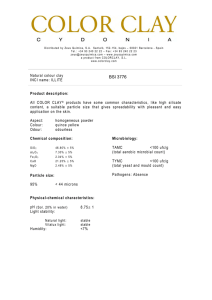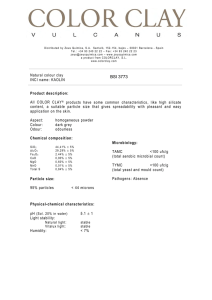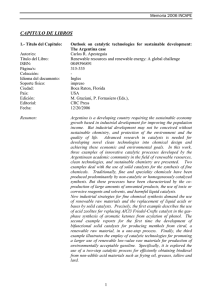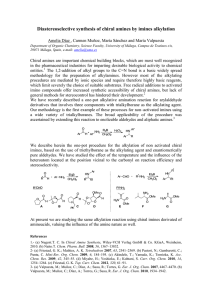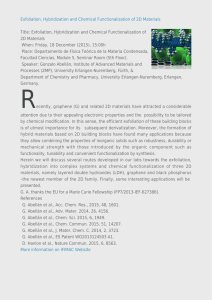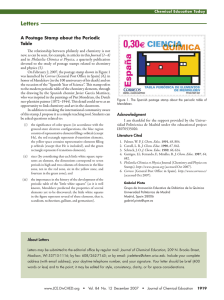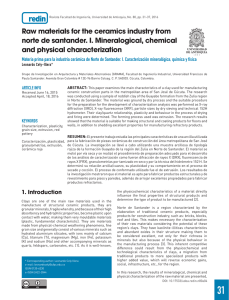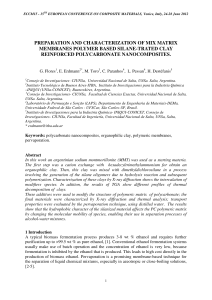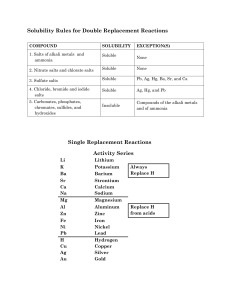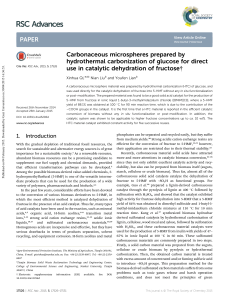Catalytic Synthesis of 1,3,5-Triphenylbenzenes, β
Anuncio
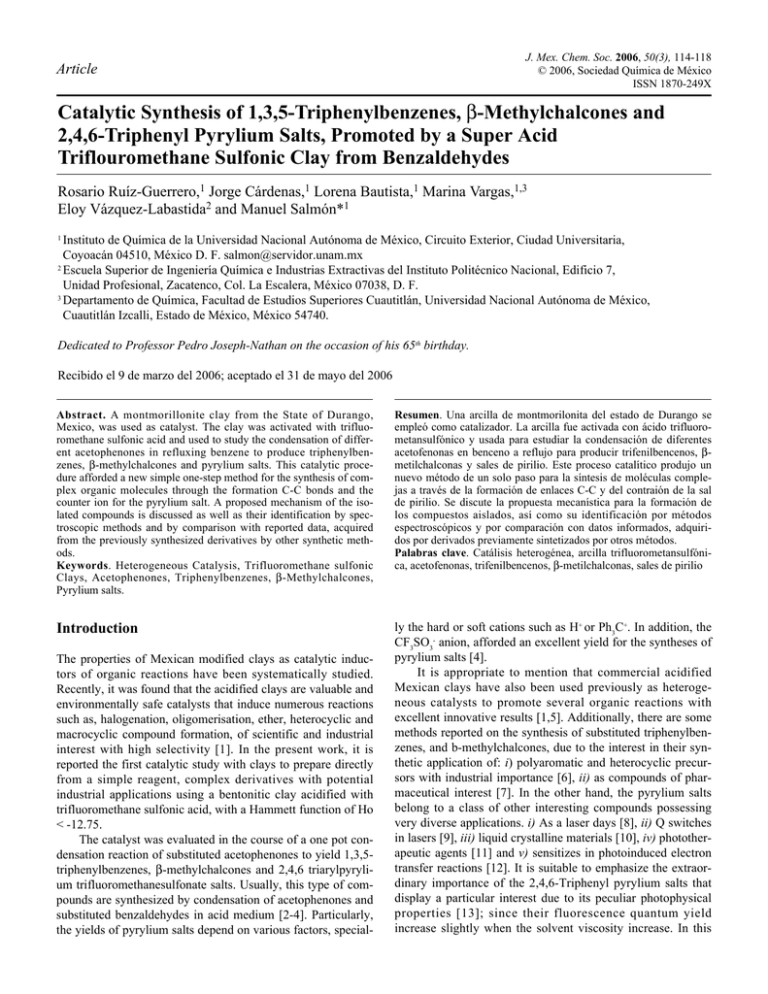
J. Mex. Chem. Soc. 2006, 50(3), 114-118 © 2006, Sociedad Química de México ISSN 1870-249X Article Catalytic Synthesis of 1,3,5-Triphenylbenzenes, β-Methylchalcones and 2,4,6-Triphenyl Pyrylium Salts, Promoted by a Super Acid Triflouromethane Sulfonic Clay from Benzaldehydes Rosario Ruíz-Guerrero,1 Jorge Cárdenas,1 Lorena Bautista,1 Marina Vargas,1,3 Eloy Vázquez-Labastida2 and Manuel Salmón*1 Instituto de Química de la Universidad Nacional Autónoma de México, Circuito Exterior, Ciudad Universitaria, Coyoacán 04510, México D. F. salmon@servidor.unam.mx 2 Escuela Superior de Ingeniería Química e Industrias Extractivas del Instituto Politécnico Nacional, Edificio 7, Unidad Profesional, Zacatenco, Col. La Escalera, México 07038, D. F. 3 Departamento de Química, Facultad de Estudios Superiores Cuautitlán, Universidad Nacional Autónoma de México, Cuautitlán Izcalli, Estado de México, México 54740. 1 Dedicated to Professor Pedro Joseph-Nathan on the occasion of his 65th birthday. Recibido el 9 de marzo del 2006; aceptado el 31 de mayo del 2006 Abstract. A montmorillonite clay from the State of Durango, Mexico, was used as catalyst. The clay was activated with trifluoromethane sulfonic acid and used to study the condensation of different acetophenones in refluxing benzene to produce triphenylbenzenes, β-methylchalcones and pyrylium salts. This catalytic procedure afforded a new simple one-step method for the synthesis of complex organic molecules through the formation C-C bonds and the counter ion for the pyrylium salt. A proposed mechanism of the isolated compounds is discussed as well as their identification by spectroscopic methods and by comparison with reported data, acquired from the previously synthesized derivatives by other synthetic methods. Keywords. Heterogeneous Catalysis, Trifluoromethane sulfonic Clays, Acetophenones, Triphenylbenzenes, β-Methylchalcones, Pyrylium salts. Resumen. Una arcilla de montmorilonita del estado de Durango se empleó como catalizador. La arcilla fue activada con ácido trifluorometansulfónico y usada para estudiar la condensación de diferentes acetofenonas en benceno a reflujo para producir trifenilbencenos, βmetilchalconas y sales de pirilio. Este proceso catalítico produjo un nuevo método de un solo paso para la síntesis de moléculas complejas a través de la formación de enlaces C-C y del contraión de la sal de pirilio. Se discute la propuesta mecanística para la formación de los compuestos aislados, así como su identificación por métodos espectroscópicos y por comparación con datos informados, adquiridos por derivados previamente sintetizados por otros métodos. Palabras clave. Catálisis heterogénea, arcilla trifluorometansulfónica, acetofenonas, trifenilbencenos, β-metilchalconas, sales de pirilio Introduction ly the hard or soft cations such as H+ or Ph3C+. In addition, the CF3SO3- anion, afforded an excellent yield for the syntheses of pyrylium salts [4]. It is appropriate to mention that commercial acidified Mexican clays have also been used previously as heterogeneous catalysts to promote several organic reactions with excellent innovative results [1,5]. Additionally, there are some methods reported on the synthesis of substituted triphenylbenzenes, and b-methylchalcones, due to the interest in their synthetic application of: i) polyaromatic and heterocyclic precursors with industrial importance [6], ii) as compounds of pharmaceutical interest [7]. In the other hand, the pyrylium salts belong to a class of other interesting compounds possessing very diverse applications. i) As a laser days [8], ii) Q switches in lasers [9], iii) liquid crystalline materials [10], iv) phototherapeutic agents [11] and v) sensitizes in photoinduced electron transfer reactions [12]. It is suitable to emphasize the extraordinary importance of the 2,4,6-Triphenyl pyrylium salts that display a particular interest due to its peculiar photophysical properties [13]; since their fluorescence quantum yield increase slightly when the solvent viscosity increase. In this The properties of Mexican modified clays as catalytic inductors of organic reactions have been systematically studied. Recently, it was found that the acidified clays are valuable and environmentally safe catalysts that induce numerous reactions such as, halogenation, oligomerisation, ether, heterocyclic and macrocyclic compound formation, of scientific and industrial interest with high selectivity [1]. In the present work, it is reported the first catalytic study with clays to prepare directly from a simple reagent, complex derivatives with potential industrial applications using a bentonitic clay acidified with trifluoromethane sulfonic acid, with a Hammett function of Ho < -12.75. The catalyst was evaluated in the course of a one pot condensation reaction of substituted acetophenones to yield 1,3,5triphenylbenzenes, β-methylchalcones and 2,4,6 triarylpyrylium trifluoromethanesulfonate salts. Usually, this type of compounds are synthesized by condensation of acetophenones and substituted benzaldehydes in acid medium [2-4]. Particularly, the yields of pyrylium salts depend on various factors, special- Catalytic Synthesis of 1,3,5-Triphenylbenzenes, β-Methylchalcones... 115 work, four different trifluoromethane sulfonic pyrylium structures were synthesized, all of them possess diverse color and fluorescent properties provided by the substituents. (IV) formation. Thus, the β-methylchalcones (3a-3e) and its derivatives in presence of the clay, yield different pyrylium salts (Scheme 3). The pyrylium salts 4a and 4b were previously synthesized by a more elaborated synthetic method using PhCOCH:CPhCH2COPh (1,3,5-triphenyl-2-pentene-1,5 dione) in presence of CF3SO3H acid [15]. Further, Bockman synthesize these compounds by a reversible reduction and electrontransfer equilibrium from pyrazolyl-hydroborate salts [17]. Notwithstanding, using the catalytic procedure reported in this work, pyrylium salts 4c and 4d where synthesized in one step and characterized for the first time. In our consideration it is particularly interesting to mention that the catalytic reaction with the 2-Bromo-4’-phenylacetophenone exclusively produces the 2,4,6-tris (phenyl, 4’phenyl) pyrylium salt (4c). In conclusion, using an acidified bentonite clay we were able to synthesize for the first time four promising dyes with photo physical properties, four b-Methylchalcones and four 1,3,5-triphenylbenzenes with high efficiency by a catalytic method. Additionally two new pyrylium salts were specifically synthesized. The simple one step reaction was made in heterogeneous phase by refluxing (in toluene) the super acid sulfonic clay (SASC) and the respective substituted acetophenone. Furthermore, all the products represent important materials for several uses in pharmaceutical, biological or photo-physical application. Results and discussion General condensation reactions of acetophenones 1a-e catalyzed with the trifluoromethane sulfonic clay (SASC) afforded a mixture of three products: 1,3,5-Triphenylbenzenes 2a-e, β-Methylchalcones 3a-e and the 2,4,6 Triarylpyrylium trifluoromethanesulfonate salts 4a-d are summarized in scheme 1. The proposed mechanism for all the products follow a typical condensation of acetophenones, yielding the bmethylchalcones (3a to 3e) precursors of the pyrylium salts (4a-4d) in addition to the 1,3,5-triphenylbenzenes (2a to 2e), which are formed with the condensation of three molecules of acetophenone [14]. The better yields obtained for the 1,3,5triphenylbenzenes formation were achieved with the substrates 1a, 1d, whereas 1e, 1b and 1c have the enhanced formation for the pyrylium salts. It was reported that pyrylium salts could be formed from acetophenones (I) in presence of a Lewis acid [2] or with strong mineral acids [4,15]. However, pyrylium salts are also formed from β-methylchalcones (II) in acid media, according with the mechanism proposed and depicted in scheme 2 [2,16]. The essential characteristic of this mechanism is the generation of the benzoyl cation as acylating agent and the active participation of the enolic β-methylchalcone (III) formed after the acylation step reaction. However, the new catalytic condensation reaction carried out by first time with a super acid trifluoromethane sulfonic clay differs from other synthetic methods described in literature. Nevertheless, similarly to the previously reported 2,4,6-triphenylpyrylium salt formation [2], we can consider a comparable mechanism for the pyrylium Experimental General methods. Reagent-grade solvents and chemicals were used as received from commercial suppliers unless otherwise noted. Acetone, Ethyl acetate, Methanol and Hexane, were purified by distillation. Acetophenone 1a, 4Methoxyacetophenone 1b, 4-Phenylacetophenone 1c, 3Methylacetophenone 1d and 3-Methylacetophenone 1e Scheme 1. Synthesis of 1,3,5-triphenyIbenzene, β-methylchalcones and pyrylium slats. 116 J. Mex. Chem. Soc. 2006, 50(3) Rosario Ruíz-Guerrero et al. Scheme 2. Mechanism for the pyrylium salt formation [15]. were used as they were received, from Aldrich. The montmorillonite clay sample, was collected from the State of Durango, México, purified and further modified by chemical treatment [5]. Analytical Tools. The 1H, 19F and 13C NMR spectra were acquired with a Varian Unity spectrometer at 300, and 75 MHz respectively using CDCl3 or DMSO-d6 as solvent and TMS and C6F6 as internal reference. Mass spectra were recorded on a JOEL JMS-AX 102A instrument by GC MS method FAB technique. IR was carried out with a Perkin-Elmer 552 instrument. Melting points were determined using a FisherJohns melting point apparatus and are uncorrected. The characterization of the CF3SO3- counter ion was made by 19F-NMR. The characterization of the pyrylium complexes was complemented with the UV spectroscopy analysis and the melting point of each salt. Table 1 resumes the total results of these reactions. Standard General method. 250 mg of each acetophenone (Scheme 1) and 50 mg of the super acid clay, in 10 mL of dry toluene was refluxed until the reaction was finished. The reaction progress was monitored by thin layer chromatography. At the end of each reaction, the catalyst was filtered and the products concentrated under vacuum. Thus, 1,3,5-triphenylbenzenes, and β-methyl chalcones, were obtain by dissolving them Scheme 3. Catalytic Pyrylium salt Synthesis. from the reaction mixture and further purified by column chromatography, packed with silica gel using solvent mixtures of Hexane/EtOAc. Pyrylium salts were isolated by filtration dissolving the soluble organic products and/or by soxhlet extraction with a non-polar solvents remaining the salt on the filter. Catalytic Reaction of Acetophenone with Trifluoromethanesulfonic Clay. The reaction with acetophenone (1a) yielded 1,3,5 triphenylbenzene (2a) (15%), β-methylchalcone (3a) as oily product (71%) and in a small quantity (5% yield) of 2,4,6triphenylpyrylium triflourmethanesulfonate salt (4a, see Scheme 1). This product was extracted from the clay by soxhlet using EtOH. 1,3,5 triphenylbenzene, (2a) characterization was made by comparison with the previously reported data: CAS 612-71-5, mp 176-178°C; UV (MeOH) λmax (log ε) 250 (4.76), nm; IR (KBr) νmax: 1594, 1577, 697 (aromatic structure 1,3,5 substituted) cm-1; 1H NMR (CDCl3) δ 7.8 (s, 3H), 7.7 (m, 6H aromatic ortho), 7.3-7.5 (m, 9H other aromatic); δ 13CNMR d 142.4, 141.2, 129, 127.5, 127.4, 125.2; MS-EI m/z: 306. β-Methylchalcone (1,3-Diphenyl-2-buten-1-one), (3a) Table 1. Catalytic transformation of acetophenones with a trifluoromethanesulfonic clay Substrate 1a 1b 1c 1d 1e Total yield (%) 90.85 76.5 20 95 86 Product distribution (%) (2a-2d) (3a-3d) (4a-4d) Reaction time (h) 15.15 1.5 30 34 70.70 26 60 52 5 49 20 5 - 12 10 21 24 24 Catalytic Synthesis of 1,3,5-Triphenylbenzenes, β-Methylchalcones... 117 CAS 495-45-4; mp 56°C; IR (KBr) νmax: 1656 (C=O, ketone), 1600-1575 (aromatic) cm -1 ; 1 HNMR (CDCl 3 ) δ 7.5-8 (AA´BB´C, 10H), 7.2 (s, 1H), 2.6 (s, 3H, b-Me). 13C-NMR (CDCl3) δ 192, 155, 143, 139, 132.5, 129, 128.6, 128.5, 128.3, 126.5, 19; MS-EI m/z: 222. The 2,4,6-tris phenyl pyrylium: (4a) was isolated as green powder: mp 236-238°C; UV (MeOH) λmax (log ε) 413.5 (0.968) nm; IR (KBr) νmax: 1623, 1626 (aromatic and pyrylium structure) cm-1; 1253, 845, 763 (ether bond); 1517, 1483 (C-S bond); 1597 (SO3 group) cm-1; 1HNMR (DMSO, d6 ) δ 7.3 (s, 2H aromatic meta), 6.87.6 (AA´BB´C, 15H other aromatic). 13CNMR δ 170.3, 165.7, 115.1, 135.1, 128.8, 129.8, 130.1, 135.1; 19FNMR δ 78.5 (s); FAB+-MS m/z: 309. Reaction of 3-Methylacetophenone and Trifluoromethanesulfonic Clay. The 3-methylacetophenone (1d) was catalyzed with a Trifluoromethanesulfonic Clay to yield (2d) (30%), (3d) (60%) and the pyrylium salt (4d) (5%): 1,3,5-Tris (3-methylphenyl) benzene (2d): CAS 96868-61-0; mp [19] : 124-125°C; 1HNMR (CDCl3) δ 7.7 (s, 3H), 7.1-7.7 (12H aromatic), 2.4 (s, 9H –Me): δ 13C-NMR d 128.8, 142.3, 128.1, 141.1, 141.2, 125.1, 21.5; MS-EI+ m/z: 348. The β,3,3’trimethyl-Chalcone (3d): CAS 93876-99-4; 1HNMR (CDCl3) δ 7.1-7.9 (AA´BB´C, 8H), 7.28 (s, 1H Ha), 1.7 (s, 3H b-Me), 2.3 (s, 6H -Me); MS-EI m/z: 250. The 2,4,6-tris (3-methyl phenyl) pyrylium (4d) was isolated as a green powder: mp: not determined; UV (MeOH) λmax (log e) 316 (2.132), 232.5 (0.753), 204.5 (1.083) nm; IR (KBr) νmax: 1624,1627 (aromatic and pyrylium structure): 1253, 844, 767 (ether bond); 1517, 1489 (C-S bond);1599 (SO3 group) cm-1: 1H NMR (DMSO-d6 ) δ 6.8 (s, 2H aromatic meta),6.9-7.8 (m, 12H aromatic) 2.5 (s, 9H CH3): 13C NMR δ 151, 149, 116, 132, 126.9, 128,129,134; 19 FNMR δ 78.5 (s); FAB+-MS m/z: 351. Catalytic Reaction of 4-Methoxiacetophenone with Trifluoromethanesulfonic Clay. By using 4-methoxyacetophenone (1b), were isolated the products 2b (2%), 3b (26%) and 4b in (49%). The 2,4,6- tri(4-methoxy) phenylpyrylium triflourmethanesulfonate was isolated from the reaction by precipitation in MeOH (Scheme 1, 4b). The 1,3,5-Tris (4methoxyphenyl) benzene, (2b): CAS 7509-20-8, mp 144146°C; IR (KBr) ν max 1621, 1595, 1511, 1434, 830 cm -1; 1 HNMR (CDCl3) δ 7.7 (s, 3H), 6.9-7.6 (m, 12H aromatic), 3.8 (s, 9H –OCH3); δ 13CNMR δ 127.3, 114.4, 124.5, 142.3; MSEI+ m/z: 396. 4,4’-dimethoxy-β-methylchalcone (3b): CAS 16197-83-4; mp [18]: 84-85°C; IR (KBr) νmax: 1601 (C=O, ketone), 1601-1569 (aromatic) cm-1; 1H NMR (CDCl3) δ 6.9-8 (AA´BB, 8H), 7.1 (s, 1H Ha), 3.8 (d, OMe), 2.5(s, 3H b-CH3). 13 CNMR δ 160.5, 128, 130.5, 163, 190.5, 120.6, 132.6, 153.5, 113.7, 114,135,55.4, 55.5, 18.6; MS-EI m/z: 282. 4,6-tris (4methoxyphenyl) pyrylium (4b): Orange crystals: mp 312315°C; UV (DMSO) λmax (log e) 416 (1.277), 309 (0.466), 269.5 (0.449) nm; IR (KBr) νmax: 2939 (C-H stretching of OCH3), 1629, 1486, 1464 (aromatic and pyrylium structure), 1259, 1179 (ether bond), 1512, 1486 (C-S bond), 1589 (SO3 group) cm -1; 1H NMR (DMSO, d 6 ) δ 8.7 (s, 2H aromatic meta), 8.4-8.5, 7.2-7.23 (m, 12H other aromatic except those ortho to OCH3), 3.9 (s, 9H OCH3); 13C NMR δ 1.67.8, 165.1, 115.1, 121.2, 132.1, 130.4, 164.4, 124.4; 19FNMR δ 78.5 ppm (s); FAB+-MS m/z: 399. Catalytic Reaction of 2-Bromo-4’-Phenylacetophenone with Trifluoromethanesulfonic Clay. From this catalytic reaction-using 2-bromo-4’-phenylacetophenone was isolated the 2,4,6-tris (4-phenyl-phenyl) pyrylium with low yield (4c) (20%). The salt was purified by EtOH extraction in Soxhlet, the soluble 2,4,6-tris (4-phenyl phenyl) pyrylium (4c) yielded dark red crystals; mp 237-238°C; UV (MeOH) λmax (log e) 427.5 (0.468), 286 (1.274), 208 (1.925) nm; IR (KBr) νmax: 1622,1625 (aromatic and pyrylium structure): 1252, 843, 766 (ether bond); 1515, 1487 (C-S bond); 1595 (SO3 group) cm-1; 1 HNMR (DMSO- d6 ) d 9.2 (s, 2H aromatic meta), 8.1-8.7, 7.8-8.7 (m, 23H other aromatic); 13CNMR δ 169.2, 163.6, 114.4, 128, 129.2, 127.9, 146.1, 131.3, 130.8, 129.4; 19F-NMR δ 78.5 ppm (s); FAB+-MS m/z: 537, 460, 154. Reaction of 4-Methylacetophenone with Trifluoromethanesulfonic Clay. The 4-methylacetophenone (1e) reagent in presence of Trifluoromethansulfonic Clay produce (2e) (34%) and (3e) (52%): 1,3,5-Tris (4-methylphenyl) benzene (2e): CAS 50446-43-0; mp 173 °C; 1H-NMR (CDCl 3) δ 7.7 (s, 3H), 7.2-7.6 (AA´BB´ system,12H aromatic), 2.4 (s, 9H Me): 13CNMR δ 137.2, 124.5, 129.5, 142.5, 138.4, 127.1, 21; MS-EI+ m/z: 348: (3e) β,4,4’-trimethyl Chalcone: CAS 36201-04-4; mplit [18]:57-58°C; 1H NMR (CDCl3) δ 7.1-7.9 (AA´BB´, 8H), 7.28 (s, 1H Ha), 1.7 (s, 3H b-Me), 2.3 (s, 6H -Me): 13CNMR δ 143, 129.1, 129.2, 154.3, 191.4, 133.1, 136.9, 139.8, 126.3, 128.3, 139.1, 21.1, 21.5, 18.6; MS-EI m/z: 250. Acknowledgment M. Salmón and M. Vargas gratefully acknowledges the financial support to DGAPA-PAPIIT IN104900, DGAPAIN500597, DGAPA-IN215598 and CONACyT 25267-A The authors wish to thank C. Damián, A. Peña, B. Quiroz and N. Zavala, for technical assistance. References 1. Salmón, M.; Penieres, G.; Miranda, R. J. Heterocyclic Chem. 1980, 18, 1475-1476; Miranda-Ruvalcaba, R.; Arrollo-Razo, G. A.; Penieres-Carrillo, G.; Delgado-Reyes, F.; Cabrera-Ortiz, A.; Alvarez-Toledano, C.; Salmón-Salazar, M. Trends Heterocyclic Chem. 2003, 9, 195-235. 2. Elderfield, R. C.; King, T. P. J. Am. Chem. Soc 1954, 76, 54375439. 3. Bello, A. M.; Kotra, L. Tetrahedron Lett. 2003, 44, 9271-9274. 4. Barry-Kone, N.; Fossey, J.; Loupy, A.; Sib, S.; Simalty, M.; Sorba, Bull. Soc. Chim. Fr. 1993, 130, 218-222. 118 J. Mex. Chem. Soc. 2006, 50(3) 5. Salmón, M.; Pérez-Luna, M.; López-Franco, C.; Hernández, E.; Alvarez-Ramírez, R. A.; López-Ortega, A.; Domínguez, J. M. J. Mol. Cat. A: Chem. 1997, 122, 169-174. 6. Hong Cheng, X.; Hoger, S.; Fenske, D. Org. Lett. 2003, 5, 25872589. 7. Climent, M. J.; Corma, A.; Iborra, S.; Primo, J. J. Catal. 1995, 151, 60-66. 8. Basting, D.; Schaefer, F. P.; Steyer, B. New J. Chem. 1974, 14, 81-88. 9. Kopainsky, B.; Kaiser, W.; Drexhage, K. H. Optics Commun. 1980, 32, 451-455. 10. Markovitsi, D.; Lecuyer, I.; Clergeot, B.; Jallabert, C.; Strzelecka, H.; Veber, M. Liquid Cryst. 1989, 6, 83-92. 11. Detty, M. R.; Merkel, P. B.; Gibson, S. L.; Hilf, R. Oncology Res. 1992, 4, 367-673. Rosario Ruíz-Guerrero et al. 12. Miranda, M. A.; García, H. Chem. Rev 1994, 94, 1063-1089. 13. Chen, Y.; Shi-Kang, W. J. Photochem. Photobio. A: Chem. 1997, 102, 203-206. 14. Elmorsy, S. S.; Khalil, A. G. M.; Girges, M. M.; Salama, T. A. J. Chem. Res. 1997, 1537-1544. 15. Katritzky, A. R.; EL-Mowaafy, A. M.; Marzorati, L.; Patel, R. C.; Thind, S. S. J. Chem. Res. S. 1980, 9, 310-311. 16. Lombard, R.; Stephan, J.-P. Bull. Soc. Chim. Fra. 1957, 1, 13691373; Lombard, R.; Stephan, J.-P. Bull. Soc. Chim. Fr. 1958, 1, 1458-1462. 17. Bockman, T. M.; Koich, J. K. New J. Chem. 1992, 16, 39-49. 18. Barker, S. A.; Riley, T. J. Chem. Soc. Perkin Transaction 1 1972, 6, 809-812. 19. Sendhoff, N.; Kissener, W.; Voegtle, F.; Franken, S.; Puff, H. Chem. Ber. 1988, 121, 2179-2185.

